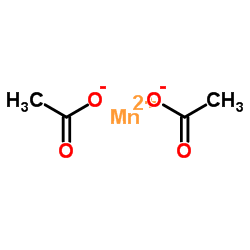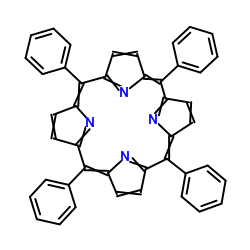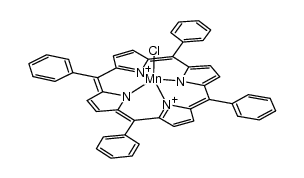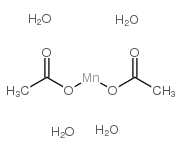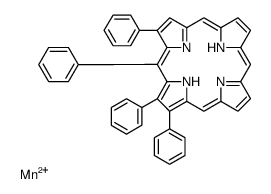58356-65-3
| Name | acetic acid,manganese(2+),5,10,15,20-tetraphenylporphyrin-22,24-diide |
|---|---|
| Synonyms |
2,7,12,17-tetraphenyl-21,23,24,25-tetraaza-22-manganahexacyclo[9.9.3.1^{3,6}.1^{13,16}.0^{8,23}.0^{18,21}]pentacosa-1,3(25),4,6,8,10,12,14,16(24),17,19-undecaene
MFCD00216548 Mn(TPP)(OAc) Mn(meso-tetraphenylporphyrin)OAc manganese(III)(meso-tetraphenylporphyrin)OAc MANGANESE meso-TETRAPHENYLPORPHINE ACETATE acetato[5,10,15,20-tetra(phenyl)porphyrinato]manganese(III) |
| Molecular Formula | C46H32MnN4O2 |
|---|---|
| Molecular Weight | 727.71000 |
| Exact Mass | 727.19100 |
| PSA | 71.88000 |
| LogP | 6.52870 |
| Appearance | Powder | greenish black |
|
Section 1: Product Identification Chemical Name:Manganese (III) meso-tetraphenylporphine acetate CAS Registry Number:58356-65-3 Formula:Mn(C44H28N4)OOCCH3 EINECS Number:none Chemical Family:metal porphine (porphyrin) complex Synonym:Manganic (III) meso-tetraphenylporphine acetate
Section 2: Composition and Information on Ingredients IngredientCAS NumberPercentACGIH (TWA)OSHA (PEL) Title compound58356-65-3100%0.2mg/m3 (as Mn)5mg/m3 (as Mn - Section 3: Hazards Identification Emergency Overview:May be irritating to eyes, skin and respiratory tract. May be harmful if swallowed. Primary Routes of Exposure:Inhalation, ingestion. Eye Contact:May cause slight to mild irritation of the eyes. Skin Contact:May cause slight to mild irritation of the skin. Dust may be irritating to the nose, mucous membranes and respiratory tract and cause chronic health Inhalation: problems. Ingestion:No information available on the physiological effects of ingestion. Acute Health Affects:May be irritating to skin, eyes and respiratory tract. Prolonged exposure to manganese containing dust may produce manganese pneumonitis and manganese Chronic Health Affects:poisoning. Symptoms include sleepiness, weakness and emotional disturbances. Equivocal studies have shown manganese may decrease fertility in men. NTP:No IARC:No OSHA:No SECTION 4: First Aid Measures Immediately flush the eyes with copious amounts of water for at least 10-15 minutes. A victim may need Eye Exposure: assistance in keeping their eye lids open. Get immediate medical attention. Wash the affected area with water. Remove contaminated clothes if necessary. Seek medical assistance if Skin Exposure: irritation persists. Remove the victim to fresh air. Closely monitor the victim for signs of respiratory problems, such as difficulty in Inhalation: breathing, coughing, wheezing or pain. In such cases seek immediate medical assistance. Seek medical attention immediately. Keep the victim calm. Give the victim water (only if conscious). Induce Ingestion: vomiting only if directed by medical personnel. SECTION 5: Fire Fighting Measures Flash Point:no data Autoignition Temperature:no data Explosion Limits:none Extinguishing Medium:carbon dioxide, foam or dry powder. If this product is involved in a fire, firefighters should be equipped with NIOSH approved positive pressure Special Fire Fighting Procedures: self-contained breathing apparatus and full protective clothing. Hazardous Combustion andIf involved in a fire this material may emit toxic manganese oxide fumes. Decomposion Products: Unusual Fire or Explosion Hazards: Combustible material. No unusual fire or explosion hazards. SECTION 6: Accidental Release Measures Spill and Leak Procedures:Small spills can be mixed with vermiculite or sodium carbonate and swept up. SECTION 7: Handling and Storage Handling and Storage:Store the material in a sealed container. Keep away from heat and moisture. SECTION 8: Exposure Controls and Personal Protection Eye Protection:Always wear approved safety glasses when handling a chemical substance in the laboratory. Skin Protection:Wear protective clothing and gloves. Ventilation:Material may form a fine dust. If possible, handle the material in an efficient fume hood. If ventilation is not available a respirator should be worn. The use of respirators requires a Respiratory Respirator: Protection Program to be in compliance with 29 CFR 1910.134. Ventilation:Material may form a fine dust. If possible, handle the material in an efficient fume hood. Additional Protection:No additional protection required. SECTION 9: Physical and Chemical Properties Color and Form:greenish black pwdr. Molecular Weight:726.71 Melting Point:no data Boiling Point:no data Vapor Pressure:no data Specific Gravity:no data Odor:not determined Solubility in Water:insoluble SECTION 10: Stability and Reactivity Stability:air and moisture stable Hazardous Polymerization:no hazardous polymerization. Conditions to Avoid:none Incompatibility:oxidizing agents and halogens Decomposition Products:carbon dioxide, carbon monoxide, organic fumes, nitrogen oxides and manganese oxide. SECTION 11: Toxicological Information RTECS Data:No information available in RTECS. Carcinogenic Effects:No data available Mutagenic Effects:No data available Tetratogenic Effects:No data available SECTION 12: Ecological Information Ecological Information:No information available. SECTION 13: Disposal Considerations Disposal:Dispose of according to local, state and federal regulations. SECTION 14: Transportation Shipping Name (CFR):Non-hazardous Hazard Class (CFR):NA Additional Hazard Class (CFR):NA Packaging Group (CFR):NA UN ID Number (CFR):NA Shipping Name (IATA):Non-hazardous Hazard Class (IATA):NA Additional Hazard Class (IATA):NA Packaging Group (IATA):NA UN ID Number (IATA):NA SECTION 15: Regulatory Information TSCA:Not listed in the TSCA inventory. SARA (Title 313):Title compound: See category code N450 for reporting Second Ingredient:none SECTION 16 - ADDITIONAL INFORMATION N/A |
|
~98% 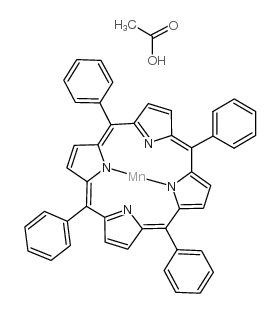
58356-65-3 |
| Literature: Chatel, Gregory; Goux-Henry, Catherine; Kardos, Nathalie; Suptil, Joel; Andrioletti, Bruno; Draye, Micheline Ultrasonics Sonochemistry, 2012 , vol. 19, # 3 p. 390 - 394 |
|
~% 
58356-65-3 |
| Literature: Inorganic Chemistry, , vol. 26, p. 2612 - 2618 |
|
~% 
58356-65-3 |
| Literature: Canadian Journal of Chemistry, , vol. 67, p. 545 - 550 |
|
~% 
58356-65-3 |
| Literature: Russian Journal of Inorganic Chemistry (Translation of Zhurnal Neorganicheskoi Khimii), , vol. 24, p. 874 - 878 Zhurnal Neorganicheskoi Khimii, , vol. 24, p. 1574 - 1581 |
| Precursor 4 | |
|---|---|
| DownStream 1 | |
